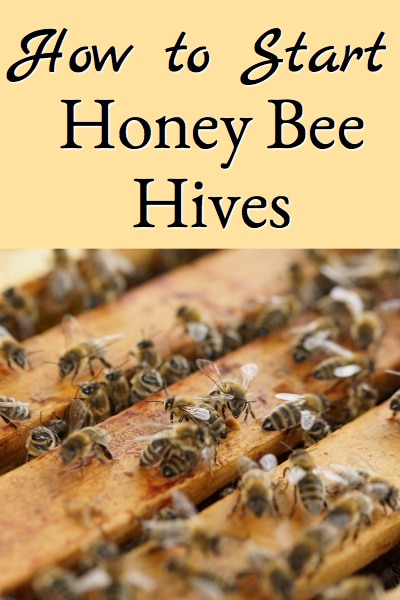
The bees typically arrive in late April or early May in our area, and once they arrive, they need to be picked up and hived within a couple of days or they’ll run out of food and die.
Bee packages come in different sizes; however, a common size is a three-pound box that contains a queen and about 10,000 – 15,000 bees. Each package goes into one hive.
Our beekeeping practices are pretty traditional, and hiving honey bees consists of the following steps for us:
How To Start Honey Bee Hives:
Step 1 – Prepare the Honey Bee Hive Components
The hive parts that will be exposed to the elements are primed and painted to help them withstand the elements longer:

Preparing Honey Bee Hive Components
Hive stands are constructed to get the hives off the ground, and help protect the honeybees from predators:
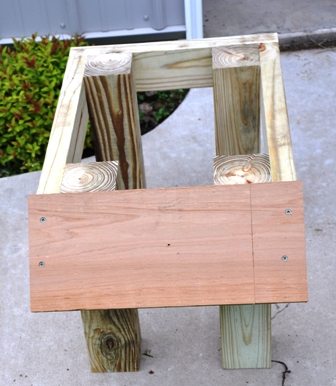
Bee Hive Stand
Step 2 – Assemble the Honey Bee Hives
The picture below shows the hive assembled – waiting for the bees. Note the “shoes” on the bottom of the stand legs – we’ll put oil in those containers to prevent ants from crawling up the legs and attacking the bees.
The slanted front piece is a “bee landing zone”. The parts of the hive that are shown are (starting from the bottom) the hive stand, bottom board, lower deep (brood chamber), inner cover, top feeder, and outer cover. Pieces that are not shown now but would be added during the honey season are an upper deep (food chamber), and supers.
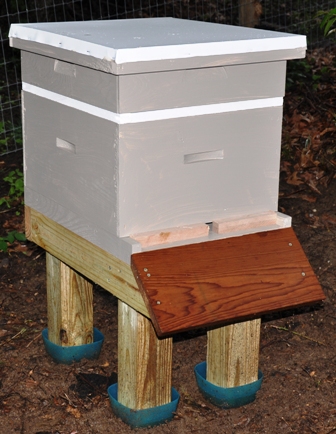
Assembled Honey Bee Hive
Step 3 – Pick Up the Honey Bee Packages
The boxes of bees packages look like the photo below (the picture below is of one 3 lb. box).
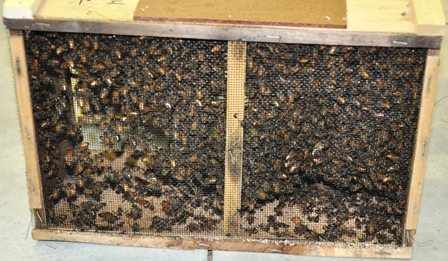
Honey Bee Package
Step 4 – Install the Queen
Time to put the bees in, first the queen gets removed from the shipping container:
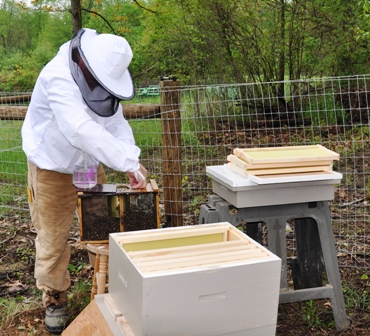
Removing The Queen
She comes in her own little individual cage; with her own workers. The end of her container is plugged with “candy” which the workers will eat through to release her into the hive. While they’re eating through the “candy”, the other bees shipped with her become used to her scent; and should then (hopefully) accept her as their queen when she actually enters the hive.
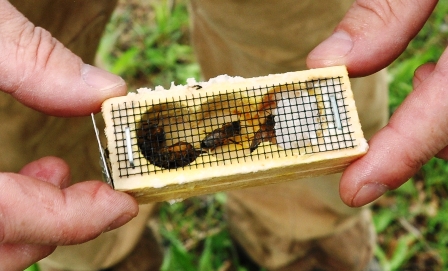
The Queen & Her Workers
The queen in her little container gets placed into the center of the lower deep (her container is that little tiny square you see between the frames (divider looking things) below):
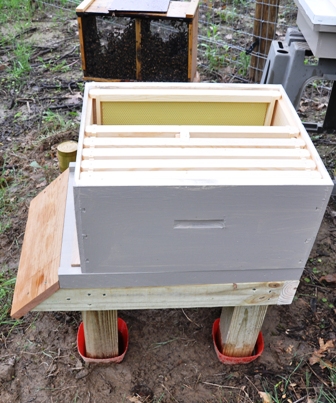
Queen Cage Placed In The Hive
Step 5 – Hiving the Honey Bees
Now, the exciting part – the bees go in! First, the bees are sprayed down well with sugar water so they can’t fly away and will fall into the hive. Then, a softball size clump of bees is added around the queen. Finally, the rest are added in the opening between the removed frames.
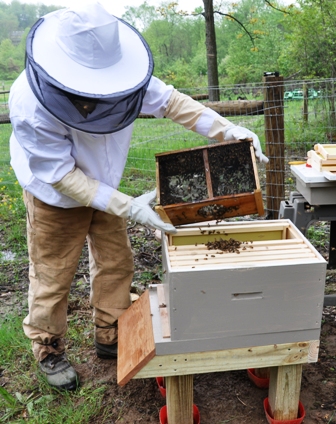
Adding Honey Bees To The HIve
The removed frames are carefully (so as not to crush any bees) added:
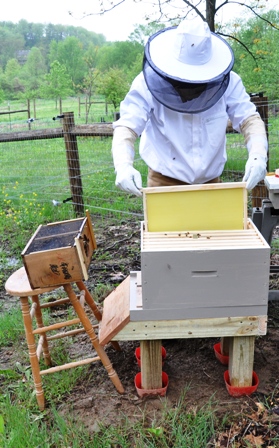
Adding Frames Back Into The Hive Box
And finally, the inner cover goes on, followed by the top feeder, and outer cover. The top feeder holds sugar water to feed the bees as they get established. We repeat this process for each bee package. Then, we wait to see if the workers accept their queens.
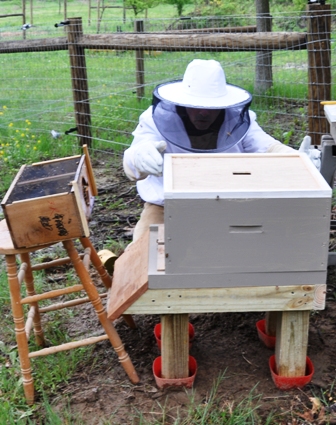
Putting The Covers On
After all the honey bees are in, then it’s time to wait a few days before Inspecting the Hive After Installing A Queen.
Scott Peloquin says
I’m new to bee keeping and have wild bees around my house I’m putting sugar water in a new hive . What I would like to know is if the bees will swarm and bring the queen to this hive if I keep the sweet water in it .
Linda Baker says
I am just getting started regarding becoming a bee keeper. Looking forward to your publication.
Lesa says
Congratulations on getting started; however, I’m not planning any publication on honey bees other than this website.
Amy @ The Quiet Homemaker says
Thank you for sharing this. I love bees so much and can not wait to one day have my own little hive!
Visiting from Bloom Where You Are Planted
Blessings,
Amy
Tanya Wersinger says
You are so lucky to have bees. This year, my yard which is covered clovers, has one or two bees buzzing around:( only a couple of years ago there were hundreds). I know that the pesticides are taking a toll on the bee population. I’m in Upstate SC. I don’t keep bees (since we live in a restrictive neighborhood). I am happy you have your hives and are increasing the colonies. And thank you for sharing your photos and explanations. Tanya
Gleniece Lytle says
Hello, Lesa. Thank you so much for this tutorial. My husband and I have been wanting to become beekeepers here in Arizona. I appreciate seeing the process from someone who has done it well.
I hope your bees establish themselves in their new homes.
Lesa says
Hi Gleniece, the honey bees have established themselves in all four new hives, and all seem to be doing well. I hope you and your husband follow up on becoming beekeepers, and you might want to contact your local beekeeping associations – they can be a wealth of help and mentoring!